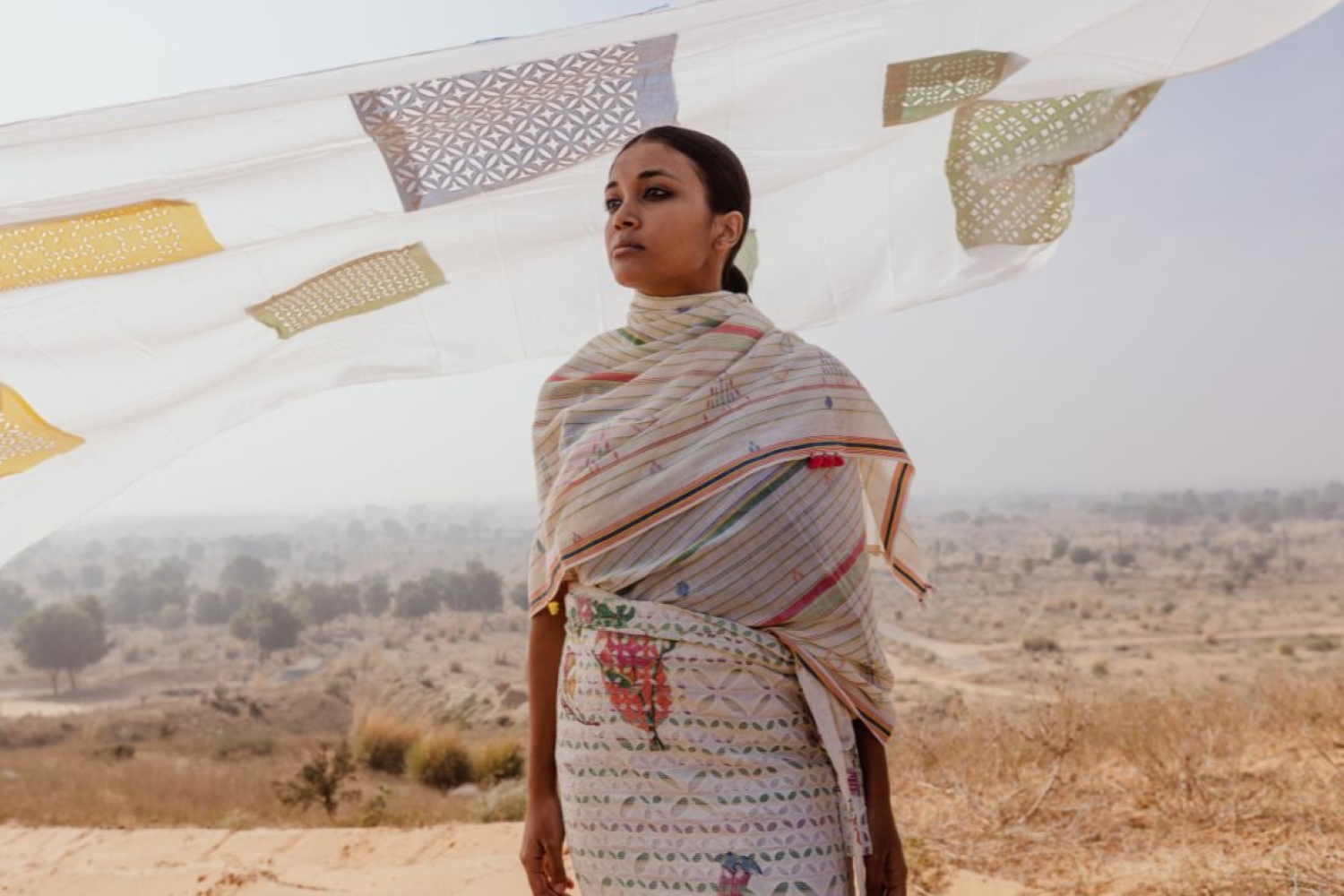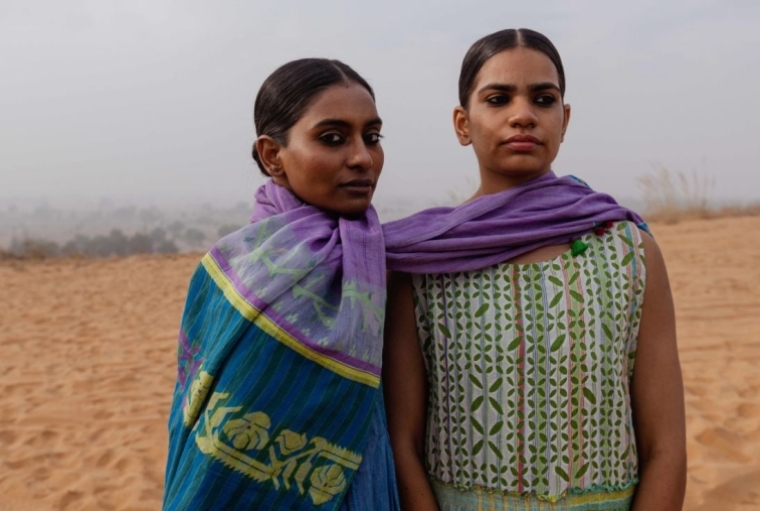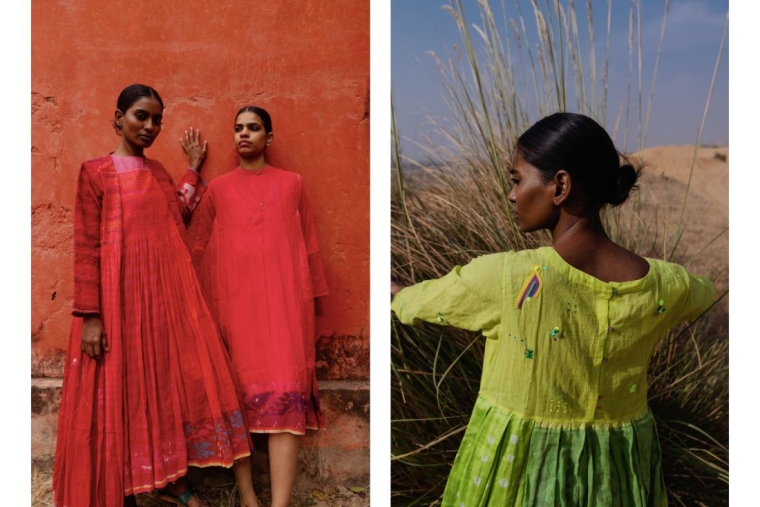

Chinar Farooqui of Injiri grew up in some of the remotest regions of Rajasthan while engaging with the local arts and crafts. She trotted along with her mother as she visited many cloth centres, one of them being Akola, the hub of indigo dyeing. As a young girl what stayed with her the most was the process and the scale of hand production. It formed the basis of her design philosophy. But has she been able to practice her roots after all these years of fast fashion and consumption? The answer is a definite yes.
Chinar had envisioned the great future of handloom textiles fifteen years back and their capacity to flourish in the current global market. Now year after year, despite making clothes with the same technique and weavers from the same craft clusters, they breathe fresh perspective, colours and silhouettes. Her new collection called Jodhpur took her back home more with a victory lap of staying true to her ethos that was born in the lanes of her childhood. She tells us more.
Reflection after Fourteen Years
My father was posted in remote areas of Rajasthan such as Churu, Nagaur, Sikar and many more. These impressions that I carried with me as a child travelling to different parts of Rajasthan lie in the interiors of the state, where I not only saw processes but also saw the use of these textiles in people's daily lives.
Very often one would see the Jat Women in Ghagras which were printed in Akola, and tie dyes odhanis. The men in their beautiful block-printed turbans and white kameez and a draped lower garment. So, these were visuals that again formed very deep impressions in my head. Now, when I started the brand, it was like this intense need to be able to create something with what inspired me as a child as a textile designer. After fifteen years of working with craft, of course, many things have changed. Initially, when I graduated from NID and started working with textiles, for one year, I was working with somebody in London and I was trying to create handloom textiles for their use. I travelled a lot to Ladakh, Chanderi, Maheshwar, Calcutta and more. There was this constant feeling inside me where I thought that the handloom had too much to offer to the contemporary clothing world. I was too inspired by local textiles, and crafts in general, and I wanted to interpret the nostalgia by creating contemporary work.
When I initially started the brand, I was very sure that handlooms were very important. A lot of people were working on such things but I was not aware of it because we had no social media at that time and I didn't see it in my ecosystem. I felt there was a huge future. After 14 and a half years in the craft clusters, I have evolved with some ideas that got reconfirmed. Initially, I was not sure when I was starting, but over the years after having worked with these clusters, I found meaning for Injiri. Now after so many years, the clusters have become independent, and because of technology, and social media, they can work with so many more people. In that sense, I'm very happy.

Falling back on Beauty
As an artist and a person who is creative and visual, I always fall back on beauty as something that guides me to do my next work. While working in the present for this year, I already have some visual images in my head, which I want to pursue. So it's a very intuitive way of working. Initially when I started, I would travel a lot, I would go to many museums, but now, I don't need that because I have so much inspiration within me. I am quite motivated all the time.
Jodhpur and Its Colours
Home has changed a lot because 20-25 years ago, many more people wore traditional and locally made textiles. Now, it is difficult to find people wearing traditional clothing and locally made textiles. Also, people's dressing styles has become very monotonous in the sense that everybody is dressing in a similar manner. Most people are wearing trousers and shirts, even in the villages. So, things have changed a lot.
The starting point of the collection basically was color. Rajasthan has been in my conscience for many decades. On a costume project for Rahul Jain, who was working with Mehrangarh fort, I spent a month drawing and studying the costumes of Jodhpur, which were in the museum at Mehrangarh. I remember those four weeks of spending time in that fort, where one would come across a lot of people dressed in beautiful colors. I think that stayed with me. It is literally inspired by Jodhpur. Blues, yellows, pinks and reds, are the colours that people like to dress there. This collection is an expression of the beauty that I find in local cultures and their strength. It's my point of view of what is beautiful.
Traditional Ideas of Craft
My creative process centres around working with the same family of weavers and the same technique year after year. When I was working on Jodhpur, I knew that my inspiration was colours and I wanted to express the beauty of Rajasthan. But I also knew that my limitation was Jamdani, the family of weavers, I have worked with for almost 10 to 12 years. The creative process was quite straightforward in that sense. I cannot look for a completely new technique every season, that doesn't work for us because then the whole idea of craft doesn't work. As a brand, it is about building relationship with your weavers, where you are actually a part of them, and they are a part of us. The entire approach to work is also very nostalgic for how people in the past and would come together to create something. That idea of interdependence is beautiful. It's very important to touch upon the fact that there's no sourcing here. I feel people get easily carried away with the trends and everything becomes transactional. I would love for more people to see the intentions and form meaningful relationships with clothes and enjoy the process of wearing garments.

The Injiri Women
Most people who wear our clothes, seek beauty. They enjoy the factor of storytelling. They enjoy the process of knowing how a textile is made and converted into a garment. If they have one jamdani, then they want another piece from the bandhani. Also, what I have noticed is that Injiri women are not scared of colors. Even in London right now, the customer base is the same, they all love colors. Also, when the weather is gloomy, they like the fact that color brings them happiness.
People seek beauty and original ideas, and they enjoy wearing creative products and they tell me Injiri garments make them feel they are wearing artworks because there's so much going on in that. We’re not doing anything run off the mill and the customers appreciate the textiles and wear them as art pieces which they want to keep with them forever. So, the Injiri's wearers are very aware and conscious of beauty and mostly working people. It comes across as a brand that is full of relaxation or leisure but a lot of Injiri women go to work wearing these comfortable silhouettes.
Words Hansika Lohani
Date 22.05.2024